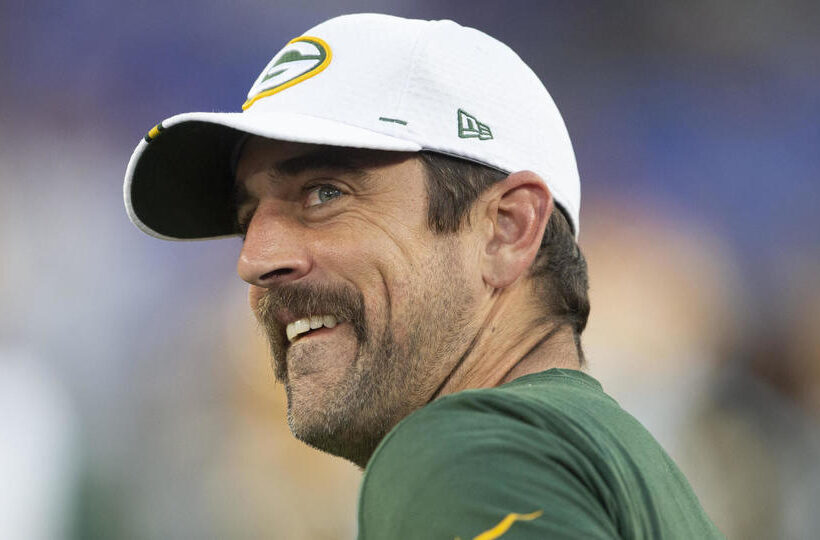Expectations for Aaron Rodgers entering his 16th NFL season seem to be lower than they ever have been in recent memory, as the Packers’ brain trust has seemingly fast tracked his eventual departure by trading up to draft the 36-year-old’s heir apparent in Jordan Love.
But are No. 12’s waning stats and the team’s apparent willingness to move on from him before his current contract expires reason enough to doubt a 2020 resurgence on the part of the signal caller in Year 2 of Matt LaFleur’s reign as head coach?
Rodgers and LaFleur have never publicly alluded to any friction between them, but watching the two operate in the young coach’s first year in Titletown indicated that the two weren’t always on the same page.
Most notably, Bleacher Report’s Mike Tanier compared Rodgers to an “old stage actor who refused to stick to the script” in describing how the starting quarterback would go from disciplined orchestra musician to full-blown improvisational jazz maestro late in games.

His ab-libing was the subject of a pre-draft interview on “The Rich Eisen Show” during which NFL Films guru Greg Cosell said, “Aaron Rodgers over the past few years has evolved or one can say devolved into a player that plays a lot outside of structure and outside of rhythm. And when you watch the coaching tape as I do, and this is not an interpretation, this is what the tape tells you. He leaves a lot of throws on the field … I guarantee you that bothers Matt LaFleur.”
But as alarming as that may sound to a dyed-in-the-wool Packer backer, history suggests that even grizzled veterans may require a first-year feeling-out period before they can fully emerge in LaFleur’s zone-blocking, run-heavy, play-action scheme inspired by 2-time Super Bowl-winning coach Mike Shanahan.
As the Atlanta Falcons’ offensive coordinator, Mike’s son, Kyle, went through his own growing pains in trying to find ways to maximize Matt Ryan’s potential in his attack. What the current 49ers’ head coach discovered was that “Matty Ice” was much more efficient as a pocket passer than he ever would be outside the tackle box.
The result: Ryan threw for career highs in yards and touchdowns as the NFL MVP in 2016.

Rodgers, while five years older than Ryan was back then, is far more mobile than the Exton, Pennsylvania native, while also being blessed with a superior throwing arm. This would lead you to believe that AR12 should naturally elevate his level of play during the upcoming season.
The beauty of the Shanahan offense, as noted by NFL Network analyst Bucky Brooks, is that it can function with an “unheralded” field general at the helm.
The system, he said, creates easy reads against simplistic coverages due to the threat of a dominant running game. All of which explains why the Packers’ primary focus in this year’s draft was to shore the ground attack by selecting 247-pound battering ram A.J. Dillon in the second round, as well as adding blocking tight end Josiah Deguara and three offensive linemen.
Said Brooks, “The heavy play-action component also leads to one-defender reads where the quarterback identifies a single defender on the second level who’ll help him determine where to go with the ball. These simple reads against basic coverages enable the QB to post a high completion percentage while pushing the ball down the field.”
This plan of attack, espoused by Sean McVay, Anthony Lynn, Kevin Stefanski and Zac Taylor, produced three of the top-four quarterbacks in play-action passing yards last season, with Jared Goff, Jimmy Garropolo and Kirk Cousins ranking first, second and fourth respectively in that area.
Basic reads resulting from a souped-up running game should logically benefit Green Bay’s receivers who will see an increasing number of opportunities to get open unimpeded by defenders dead set on neutralizing the run. It was the same exact formula the Broncos employed in the 90s and early 2000s in generating big plays to wideouts Rod Smith and Ed McCafferey and may also explain why the Packers didn’t feel compelled to invest a high draft pick — or any picks for that matter — in a wide receiver last April.
When one takes all of these factors into account, it’s clear why one can make a strong argument in favor of Rodgers transcending dour predictions being promulgated by some league pundits/analysts.
Long-time Packers’ scribe Rob Demovsky suggested that Zoom meetings between Rodgers, LaFluer, offensive coordinator Nathaniel Hackett and wide receivers coach Luke Getsy have gone well in last Friday’s write-up.
Demovsky added: “There’s a chance Rodgers and LaFleur sparked something more simpatico in their second year together.”
If all goes according to plan, Green Bay’s offense will improve its standing as the 18th-ranked team in total yardage and that will only happen with a preponderance of explosive plays. The key to unlocking the potential of the Shanahan system after all is not to operate as a monolithic ground-and-pound outfit that consistently churns out 20-play drives; it’s really all about executing explosive plays that are the offshoot of a dominant ground game.
A highly motivated Rodgers should be up to the task.
——————
When ~Reverend~ Ralph Mancini is not tackling hard news in New York City, he enjoys analyzing his favorite sports team, the Green Bay Packers. You can follow him on twitter at ReverendRalph.
——————


1 response to “The Only Way Is Up For Rodgers In LaFleur Scheme”
Packers have failed with teams put around Farve and Rodgers as HOF QBs period. Disgusting is a word to be used.